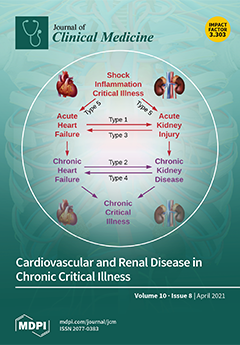Introduction: The most frequent causes of tinnitus associated with hearing loss are noise-induced hearing loss and presbycusis. The mechanism of tinnitus is not yet clear, although several hypotheses have been suggested. Therefore, we aimed to analyze characteristics of chronic tinnitus between noise-induced hearing
[...] Read more.
Introduction: The most frequent causes of tinnitus associated with hearing loss are noise-induced hearing loss and presbycusis. The mechanism of tinnitus is not yet clear, although several hypotheses have been suggested. Therefore, we aimed to analyze characteristics of chronic tinnitus between noise-induced hearing loss and presbycusis.
Materials and Methods: This paper is a retrospective chart review and outpatient clinic-based study of 248 patients with chronic tinnitus from 2015 to 2020 with noise-induced or presbycusis. Pure tone audiometry (PTA), auditory brainstem response (ABR), distortion product otoacoustic emissions (DPOAE), transient evoked otoacoustic emissions (TEOAE), and tinnitograms were conducted.
Results: PTA showed that hearing thresholds at all frequencies were higher in patients with noise-induced hearing loss than the presbycusis group. ABR tests showed that patients with presbycusis had longer wave I and III latencies (
p < 0.05 each) than patients with noise-induced hearing loss. TEOAE tests showed lower values in patients with noise-induced hearing loss than presbycusis at 1.5, 2, 3, and 4 kHz (
p < 0.05 each). DPOAE tests showed that response rates in both ears at 1.5, 2, and 3 kHz were significantly higher in patients with presbycusis than noise-induced hearing loss (
p < 0.05 each).
Discussion: This study showed that hearing thresholds were higher, the loudness of tinnitus was smaller, and the degree of damage to outer hair cells was lower in patients with presbycusis than with noise-induced hearing loss. Moreover, wave I and III latencies were more prolonged in patients with presbycusis despite their having lower hearing thresholds. These phenomena may reflect the effects of aging or degeneration of the central nervous system with age. Further studies are needed to evaluate the etiologies of tinnitus.
Full article






